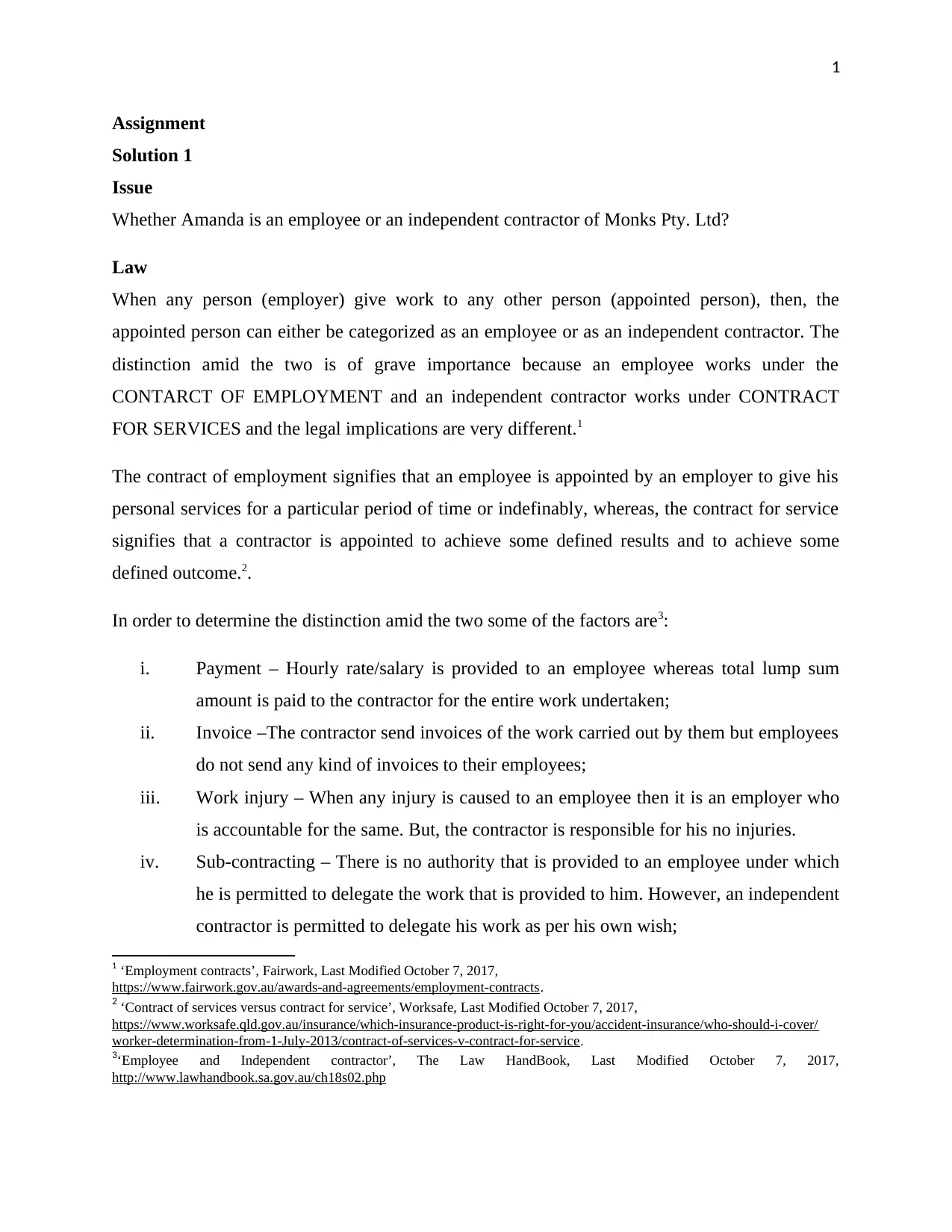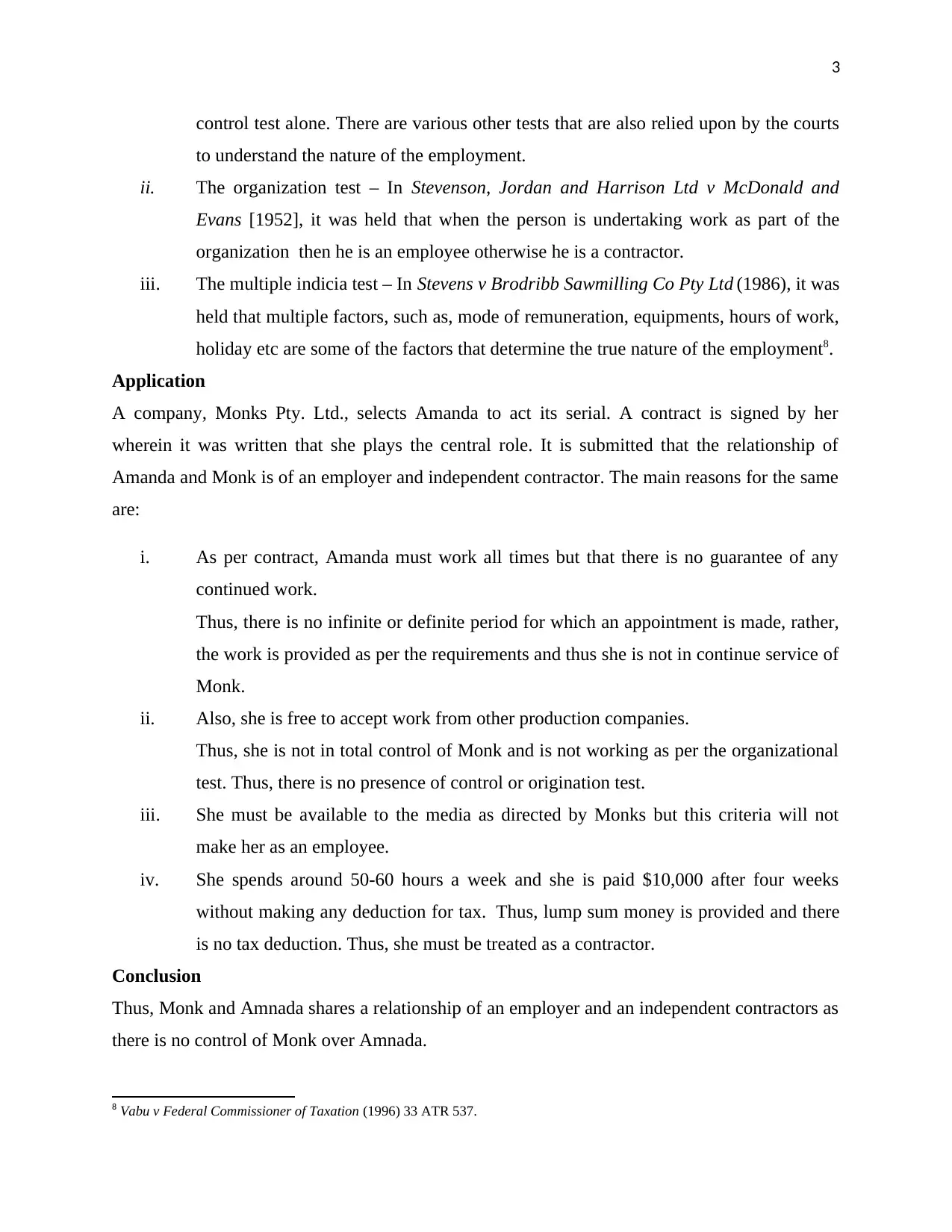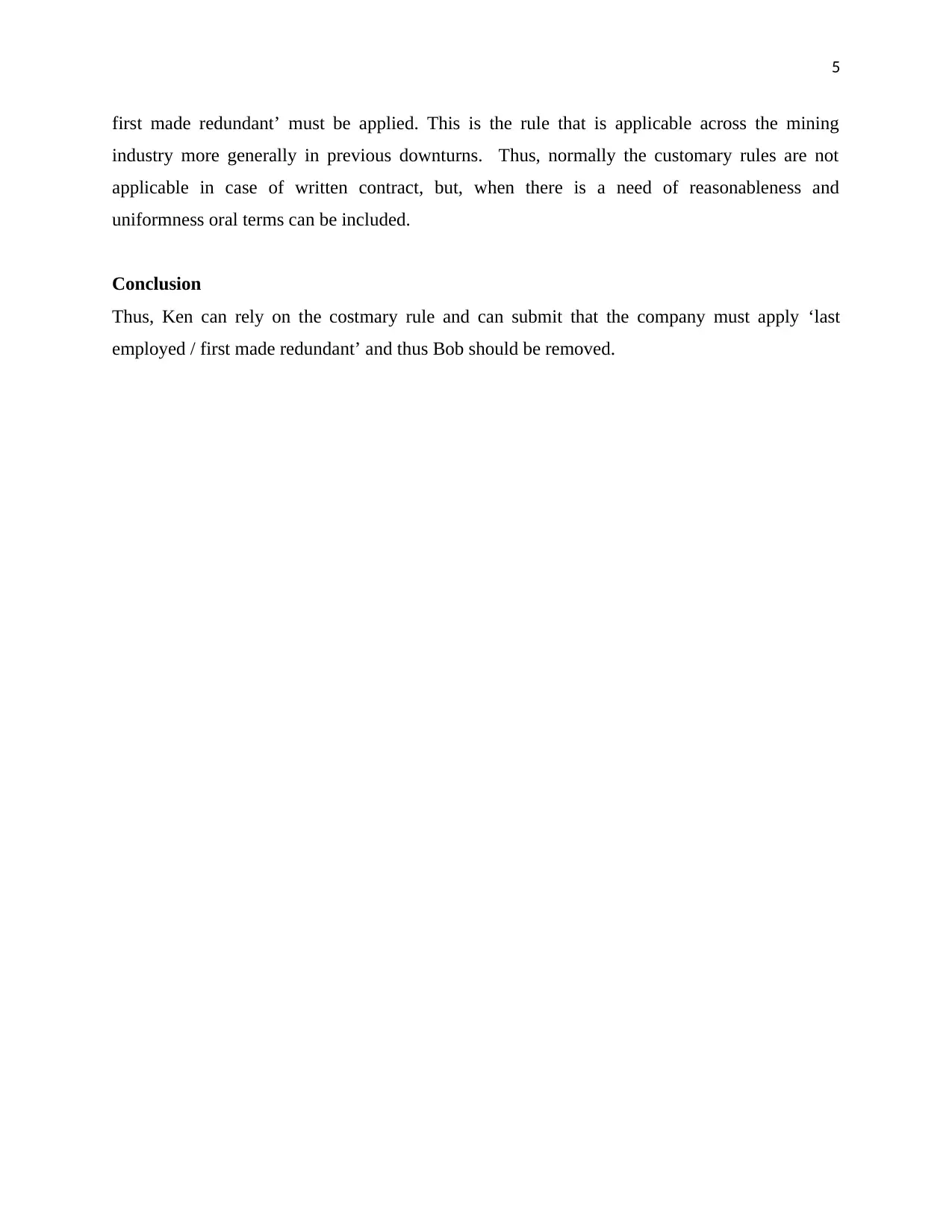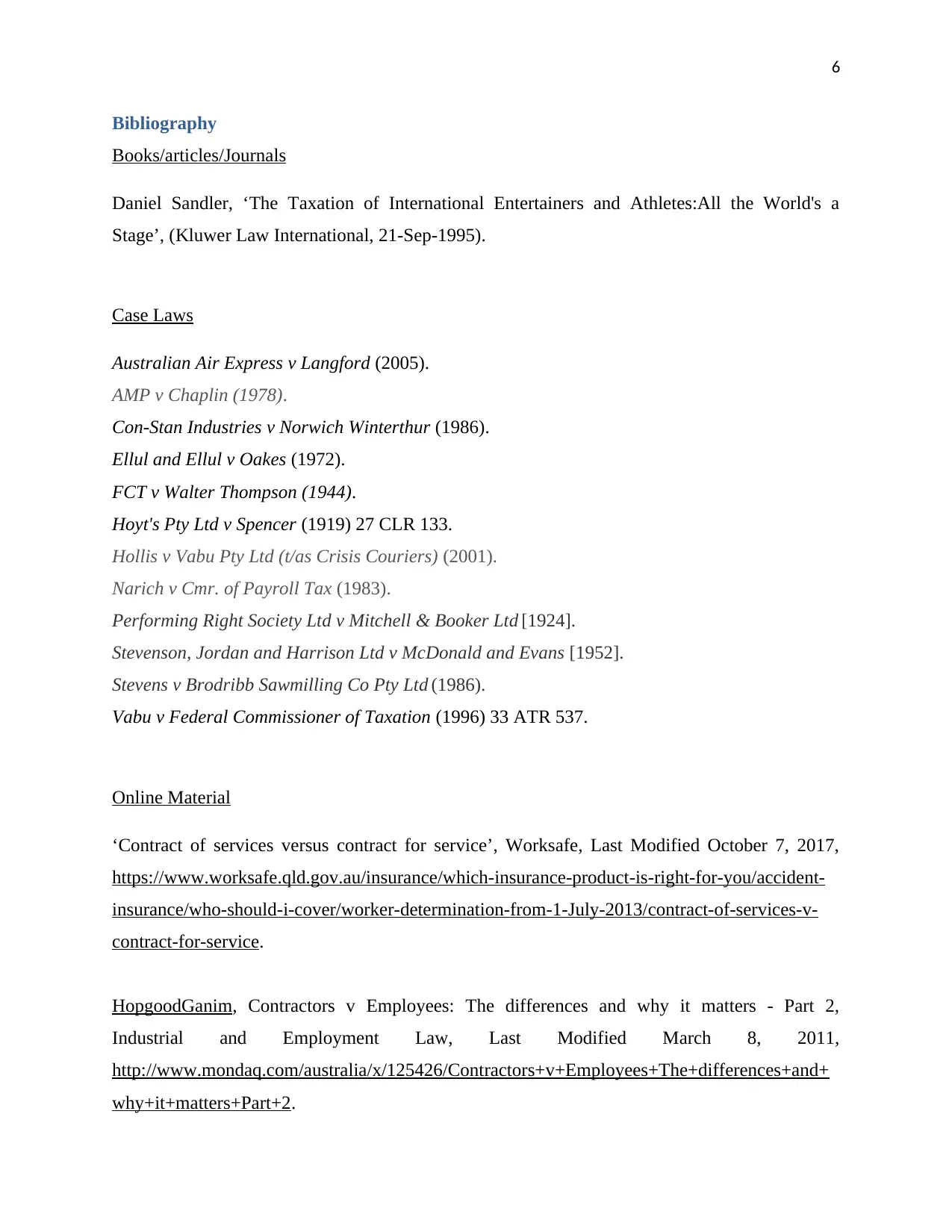Employment Law Assignment: Employee vs. Contractor Analysis
VerifiedAdded on 2020/03/23
|7
|1764
|415
Homework Assignment
AI Summary
This law assignment addresses two key employment law issues. The first part examines whether Amanda is an employee or an independent contractor for Monks Pty. Ltd., analyzing factors such as payment structure, control, and the nature of the work to determine the employment relationship. The second part focuses on whether Ken can claim the 'last on / first off' rule to avoid redundancy, considering the written contract's terms versus customary rules within the industry, and assessing the enforceability of implied terms. The assignment uses case law and legal principles to support the analysis, providing a comprehensive overview of the legal considerations in both scenarios. It considers various tests, including the control test, organizational test and multiple indicia test to determine the true nature of the employment. The analysis includes a detailed discussion of the legal implications and factors that distinguish employees from independent contractors, and the enforceability of implied terms in employment contracts.

1
Assignment
Solution 1
Issue
Whether Amanda is an employee or an independent contractor of Monks Pty. Ltd?
Law
When any person (employer) give work to any other person (appointed person), then, the
appointed person can either be categorized as an employee or as an independent contractor. The
distinction amid the two is of grave importance because an employee works under the
CONTARCT OF EMPLOYMENT and an independent contractor works under CONTRACT
FOR SERVICES and the legal implications are very different.1
The contract of employment signifies that an employee is appointed by an employer to give his
personal services for a particular period of time or indefinably, whereas, the contract for service
signifies that a contractor is appointed to achieve some defined results and to achieve some
defined outcome.2.
In order to determine the distinction amid the two some of the factors are3:
i. Payment – Hourly rate/salary is provided to an employee whereas total lump sum
amount is paid to the contractor for the entire work undertaken;
ii. Invoice –The contractor send invoices of the work carried out by them but employees
do not send any kind of invoices to their employees;
iii. Work injury – When any injury is caused to an employee then it is an employer who
is accountable for the same. But, the contractor is responsible for his no injuries.
iv. Sub-contracting – There is no authority that is provided to an employee under which
he is permitted to delegate the work that is provided to him. However, an independent
contractor is permitted to delegate his work as per his own wish;
1 ‘Employment contracts’, Fairwork, Last Modified October 7, 2017,
https://www.fairwork.gov.au/awards-and-agreements/employment-contracts.
2 ‘Contract of services versus contract for service’, Worksafe, Last Modified October 7, 2017,
https://www.worksafe.qld.gov.au/insurance/which-insurance-product-is-right-for-you/accident-insurance/who-should-i-cover/
worker-determination-from-1-July-2013/contract-of-services-v-contract-for-service.
3‘Employee and Independent contractor’, The Law HandBook, Last Modified October 7, 2017,
http://www.lawhandbook.sa.gov.au/ch18s02.php
Assignment
Solution 1
Issue
Whether Amanda is an employee or an independent contractor of Monks Pty. Ltd?
Law
When any person (employer) give work to any other person (appointed person), then, the
appointed person can either be categorized as an employee or as an independent contractor. The
distinction amid the two is of grave importance because an employee works under the
CONTARCT OF EMPLOYMENT and an independent contractor works under CONTRACT
FOR SERVICES and the legal implications are very different.1
The contract of employment signifies that an employee is appointed by an employer to give his
personal services for a particular period of time or indefinably, whereas, the contract for service
signifies that a contractor is appointed to achieve some defined results and to achieve some
defined outcome.2.
In order to determine the distinction amid the two some of the factors are3:
i. Payment – Hourly rate/salary is provided to an employee whereas total lump sum
amount is paid to the contractor for the entire work undertaken;
ii. Invoice –The contractor send invoices of the work carried out by them but employees
do not send any kind of invoices to their employees;
iii. Work injury – When any injury is caused to an employee then it is an employer who
is accountable for the same. But, the contractor is responsible for his no injuries.
iv. Sub-contracting – There is no authority that is provided to an employee under which
he is permitted to delegate the work that is provided to him. However, an independent
contractor is permitted to delegate his work as per his own wish;
1 ‘Employment contracts’, Fairwork, Last Modified October 7, 2017,
https://www.fairwork.gov.au/awards-and-agreements/employment-contracts.
2 ‘Contract of services versus contract for service’, Worksafe, Last Modified October 7, 2017,
https://www.worksafe.qld.gov.au/insurance/which-insurance-product-is-right-for-you/accident-insurance/who-should-i-cover/
worker-determination-from-1-July-2013/contract-of-services-v-contract-for-service.
3‘Employee and Independent contractor’, The Law HandBook, Last Modified October 7, 2017,
http://www.lawhandbook.sa.gov.au/ch18s02.php
Paraphrase This Document
Need a fresh take? Get an instant paraphrase of this document with our AI Paraphraser

2
v. Material – The material that is required to complete the work is normally provided to
an employee by an employer. But, in case of an contractor, the tools and material that
is acquired by the contactor on its own without any involvement of the employer;
vi. Super-annuation and tax – Normally the taxes of an employee are paid by an
employer but a contractor is accountable to pay his own taxes.
However, the courts still look into the entire situation and circumstances prior deciding whether
the relationship is of an employer-employee or employee-independent contractor. It makes no
difference what terminology is used by the parties, the court look the entire situation and then
only decides the relationship that is hold by the parties and is held in Hollis v Vabu Pty Ltd (t/as
Crisis Couriers) (2001) & AMP v Chaplin (1978). At time the employer tries to mis-quote the
relationship in order to avoid the statutory impositions but the court acts beyond the acts of the
parties and analyze the true intention of the relationship Narich v Cmr. of Payroll Tax (1983).4
At times the distinction amid an employee and an independent contractor becomes so complex
that there are several tests that are required to be determined in order to understand the true
nature of the relationship5.
i. The control Test – An employee is under the control of the employer and works as
per his directions. But a contractor is not controlled by the employer and has his own
say while performing his obligations6. Thus, if the presence of control is less than it
depicts the presence of independent contractor relationship.7
The control test is not the rule of law but it has been found from number of years that
the control test is found to be the most determining factor in order to understand the
true relationship that is shared amid the parties. In Performing Right Society Ltd v
Mitchell & Booker Ltd [1924], it was held that that it is the degree of control over the
person that determines his nature of service. But, the courts are not relying on the
4 Daniel Sandler, ‘The Taxation of International Entertainers and Athletes:All the World's a Stage’, (Kluwer Law
International, 21-Sep-1995).
5HopgoodGanim, Contractors v Employees: The differences and why it matters - Part 2, Industrial and Employment Law, Last
Modified March 8, 2011,
http://www.mondaq.com/australia/x/125426/Contractors+v+Employees+The+differences+and+why+it+matters+Part+2.
6 FCT v Walter Thompson (1944).
7 Australian Air Express v Langford (2005).
v. Material – The material that is required to complete the work is normally provided to
an employee by an employer. But, in case of an contractor, the tools and material that
is acquired by the contactor on its own without any involvement of the employer;
vi. Super-annuation and tax – Normally the taxes of an employee are paid by an
employer but a contractor is accountable to pay his own taxes.
However, the courts still look into the entire situation and circumstances prior deciding whether
the relationship is of an employer-employee or employee-independent contractor. It makes no
difference what terminology is used by the parties, the court look the entire situation and then
only decides the relationship that is hold by the parties and is held in Hollis v Vabu Pty Ltd (t/as
Crisis Couriers) (2001) & AMP v Chaplin (1978). At time the employer tries to mis-quote the
relationship in order to avoid the statutory impositions but the court acts beyond the acts of the
parties and analyze the true intention of the relationship Narich v Cmr. of Payroll Tax (1983).4
At times the distinction amid an employee and an independent contractor becomes so complex
that there are several tests that are required to be determined in order to understand the true
nature of the relationship5.
i. The control Test – An employee is under the control of the employer and works as
per his directions. But a contractor is not controlled by the employer and has his own
say while performing his obligations6. Thus, if the presence of control is less than it
depicts the presence of independent contractor relationship.7
The control test is not the rule of law but it has been found from number of years that
the control test is found to be the most determining factor in order to understand the
true relationship that is shared amid the parties. In Performing Right Society Ltd v
Mitchell & Booker Ltd [1924], it was held that that it is the degree of control over the
person that determines his nature of service. But, the courts are not relying on the
4 Daniel Sandler, ‘The Taxation of International Entertainers and Athletes:All the World's a Stage’, (Kluwer Law
International, 21-Sep-1995).
5HopgoodGanim, Contractors v Employees: The differences and why it matters - Part 2, Industrial and Employment Law, Last
Modified March 8, 2011,
http://www.mondaq.com/australia/x/125426/Contractors+v+Employees+The+differences+and+why+it+matters+Part+2.
6 FCT v Walter Thompson (1944).
7 Australian Air Express v Langford (2005).

3
control test alone. There are various other tests that are also relied upon by the courts
to understand the nature of the employment.
ii. The organization test – In Stevenson, Jordan and Harrison Ltd v McDonald and
Evans [1952], it was held that when the person is undertaking work as part of the
organization then he is an employee otherwise he is a contractor.
iii. The multiple indicia test – In Stevens v Brodribb Sawmilling Co Pty Ltd (1986), it was
held that multiple factors, such as, mode of remuneration, equipments, hours of work,
holiday etc are some of the factors that determine the true nature of the employment8.
Application
A company, Monks Pty. Ltd., selects Amanda to act its serial. A contract is signed by her
wherein it was written that she plays the central role. It is submitted that the relationship of
Amanda and Monk is of an employer and independent contractor. The main reasons for the same
are:
i. As per contract, Amanda must work all times but that there is no guarantee of any
continued work.
Thus, there is no infinite or definite period for which an appointment is made, rather,
the work is provided as per the requirements and thus she is not in continue service of
Monk.
ii. Also, she is free to accept work from other production companies.
Thus, she is not in total control of Monk and is not working as per the organizational
test. Thus, there is no presence of control or origination test.
iii. She must be available to the media as directed by Monks but this criteria will not
make her as an employee.
iv. She spends around 50-60 hours a week and she is paid $10,000 after four weeks
without making any deduction for tax. Thus, lump sum money is provided and there
is no tax deduction. Thus, she must be treated as a contractor.
Conclusion
Thus, Monk and Amnada shares a relationship of an employer and an independent contractors as
there is no control of Monk over Amnada.
8 Vabu v Federal Commissioner of Taxation (1996) 33 ATR 537.
control test alone. There are various other tests that are also relied upon by the courts
to understand the nature of the employment.
ii. The organization test – In Stevenson, Jordan and Harrison Ltd v McDonald and
Evans [1952], it was held that when the person is undertaking work as part of the
organization then he is an employee otherwise he is a contractor.
iii. The multiple indicia test – In Stevens v Brodribb Sawmilling Co Pty Ltd (1986), it was
held that multiple factors, such as, mode of remuneration, equipments, hours of work,
holiday etc are some of the factors that determine the true nature of the employment8.
Application
A company, Monks Pty. Ltd., selects Amanda to act its serial. A contract is signed by her
wherein it was written that she plays the central role. It is submitted that the relationship of
Amanda and Monk is of an employer and independent contractor. The main reasons for the same
are:
i. As per contract, Amanda must work all times but that there is no guarantee of any
continued work.
Thus, there is no infinite or definite period for which an appointment is made, rather,
the work is provided as per the requirements and thus she is not in continue service of
Monk.
ii. Also, she is free to accept work from other production companies.
Thus, she is not in total control of Monk and is not working as per the organizational
test. Thus, there is no presence of control or origination test.
iii. She must be available to the media as directed by Monks but this criteria will not
make her as an employee.
iv. She spends around 50-60 hours a week and she is paid $10,000 after four weeks
without making any deduction for tax. Thus, lump sum money is provided and there
is no tax deduction. Thus, she must be treated as a contractor.
Conclusion
Thus, Monk and Amnada shares a relationship of an employer and an independent contractors as
there is no control of Monk over Amnada.
8 Vabu v Federal Commissioner of Taxation (1996) 33 ATR 537.
⊘ This is a preview!⊘
Do you want full access?
Subscribe today to unlock all pages.

Trusted by 1+ million students worldwide

4
Solution 2
Issue
Can Ken submit that the ‘last on / first off’ rule forms part of his contract and that he should not
be made redundant before Bob?
Law
When a contract is established amid the parties, then, the parties must abide by the terms of the
contract. Terms can be oral and written. When the terms are written in a signed contract, the
parties must abide by the same irrespective of the fact whether the same are read or not9. Oral
term is not permitted to be relied upon the parties. However, there are situation wherein
regardless of the written terms, the oral terms can also be made binding upon the parties if:
i. The oral terms are necessary and are not in contradiction with the main contract.
Also, the parties would have intended that such statement to become part of the
contract10
ii. Certain terms are considered to be implied depending upon the certainty of the term ,
reasonableness and uniformness11
The law is now applied.
Application
Ken and Bob are drivers for Ore Ltd. Ken is working fir the company for 20 years, while Bob, is
a qualified person and is working for the company as an assistant for the last 18 months.
Ken was made part of the redundancy list despite of the fact that he has served the organization
for 20 years (whereas Bob is part only for 18 months). There is a contract that is signed amid the
company and Ken wherein there is no mention of any kind of rule and it only submits that the
authority of redundancy of the employee rests only with the employer.
Thus, as per Ellul and Ellul v Oakes, since the contract amid Ken and the company is written,
thus, the terms are binding irrespective whether the same are read by Ken or not.
But, as per Hoyt's Pty Ltd v Spencer and Con-Stan Industries v Norwich Winterthur, the
customary rule must be allowed to imposed upon the parties according to which ‘last employed /
9 Ellul and Ellul v Oakes (1972).
10 Hoyt's Pty Ltd v Spencer (1919) 27 CLR 133
11 Con-Stan Industries v Norwich Winterthur (1986).
Solution 2
Issue
Can Ken submit that the ‘last on / first off’ rule forms part of his contract and that he should not
be made redundant before Bob?
Law
When a contract is established amid the parties, then, the parties must abide by the terms of the
contract. Terms can be oral and written. When the terms are written in a signed contract, the
parties must abide by the same irrespective of the fact whether the same are read or not9. Oral
term is not permitted to be relied upon the parties. However, there are situation wherein
regardless of the written terms, the oral terms can also be made binding upon the parties if:
i. The oral terms are necessary and are not in contradiction with the main contract.
Also, the parties would have intended that such statement to become part of the
contract10
ii. Certain terms are considered to be implied depending upon the certainty of the term ,
reasonableness and uniformness11
The law is now applied.
Application
Ken and Bob are drivers for Ore Ltd. Ken is working fir the company for 20 years, while Bob, is
a qualified person and is working for the company as an assistant for the last 18 months.
Ken was made part of the redundancy list despite of the fact that he has served the organization
for 20 years (whereas Bob is part only for 18 months). There is a contract that is signed amid the
company and Ken wherein there is no mention of any kind of rule and it only submits that the
authority of redundancy of the employee rests only with the employer.
Thus, as per Ellul and Ellul v Oakes, since the contract amid Ken and the company is written,
thus, the terms are binding irrespective whether the same are read by Ken or not.
But, as per Hoyt's Pty Ltd v Spencer and Con-Stan Industries v Norwich Winterthur, the
customary rule must be allowed to imposed upon the parties according to which ‘last employed /
9 Ellul and Ellul v Oakes (1972).
10 Hoyt's Pty Ltd v Spencer (1919) 27 CLR 133
11 Con-Stan Industries v Norwich Winterthur (1986).
Paraphrase This Document
Need a fresh take? Get an instant paraphrase of this document with our AI Paraphraser

5
first made redundant’ must be applied. This is the rule that is applicable across the mining
industry more generally in previous downturns. Thus, normally the customary rules are not
applicable in case of written contract, but, when there is a need of reasonableness and
uniformness oral terms can be included.
Conclusion
Thus, Ken can rely on the costmary rule and can submit that the company must apply ‘last
employed / first made redundant’ and thus Bob should be removed.
first made redundant’ must be applied. This is the rule that is applicable across the mining
industry more generally in previous downturns. Thus, normally the customary rules are not
applicable in case of written contract, but, when there is a need of reasonableness and
uniformness oral terms can be included.
Conclusion
Thus, Ken can rely on the costmary rule and can submit that the company must apply ‘last
employed / first made redundant’ and thus Bob should be removed.

6
Bibliography
Books/articles/Journals
Daniel Sandler, ‘The Taxation of International Entertainers and Athletes:All the World's a
Stage’, (Kluwer Law International, 21-Sep-1995).
Case Laws
Australian Air Express v Langford (2005).
AMP v Chaplin (1978).
Con-Stan Industries v Norwich Winterthur (1986).
Ellul and Ellul v Oakes (1972).
FCT v Walter Thompson (1944).
Hoyt's Pty Ltd v Spencer (1919) 27 CLR 133.
Hollis v Vabu Pty Ltd (t/as Crisis Couriers) (2001).
Narich v Cmr. of Payroll Tax (1983).
Performing Right Society Ltd v Mitchell & Booker Ltd [1924].
Stevenson, Jordan and Harrison Ltd v McDonald and Evans [1952].
Stevens v Brodribb Sawmilling Co Pty Ltd (1986).
Vabu v Federal Commissioner of Taxation (1996) 33 ATR 537.
Online Material
‘Contract of services versus contract for service’, Worksafe, Last Modified October 7, 2017,
https://www.worksafe.qld.gov.au/insurance/which-insurance-product-is-right-for-you/accident-
insurance/who-should-i-cover/worker-determination-from-1-July-2013/contract-of-services-v-
contract-for-service.
HopgoodGanim, Contractors v Employees: The differences and why it matters - Part 2,
Industrial and Employment Law, Last Modified March 8, 2011,
http://www.mondaq.com/australia/x/125426/Contractors+v+Employees+The+differences+and+
why+it+matters+Part+2.
Bibliography
Books/articles/Journals
Daniel Sandler, ‘The Taxation of International Entertainers and Athletes:All the World's a
Stage’, (Kluwer Law International, 21-Sep-1995).
Case Laws
Australian Air Express v Langford (2005).
AMP v Chaplin (1978).
Con-Stan Industries v Norwich Winterthur (1986).
Ellul and Ellul v Oakes (1972).
FCT v Walter Thompson (1944).
Hoyt's Pty Ltd v Spencer (1919) 27 CLR 133.
Hollis v Vabu Pty Ltd (t/as Crisis Couriers) (2001).
Narich v Cmr. of Payroll Tax (1983).
Performing Right Society Ltd v Mitchell & Booker Ltd [1924].
Stevenson, Jordan and Harrison Ltd v McDonald and Evans [1952].
Stevens v Brodribb Sawmilling Co Pty Ltd (1986).
Vabu v Federal Commissioner of Taxation (1996) 33 ATR 537.
Online Material
‘Contract of services versus contract for service’, Worksafe, Last Modified October 7, 2017,
https://www.worksafe.qld.gov.au/insurance/which-insurance-product-is-right-for-you/accident-
insurance/who-should-i-cover/worker-determination-from-1-July-2013/contract-of-services-v-
contract-for-service.
HopgoodGanim, Contractors v Employees: The differences and why it matters - Part 2,
Industrial and Employment Law, Last Modified March 8, 2011,
http://www.mondaq.com/australia/x/125426/Contractors+v+Employees+The+differences+and+
why+it+matters+Part+2.
⊘ This is a preview!⊘
Do you want full access?
Subscribe today to unlock all pages.

Trusted by 1+ million students worldwide

7
‘Employment contracts’, Fair work, Last Modified October 7, 2017,
https://www.fairwork.gov.au/awards-and-agreements/employment-contracts.
‘Employee and Independent contractor’, The Law HandBook, Last Modified October 7, 2017,
http://www.lawhandbook.sa.gov.au/ch18s02.php
‘Employment contracts’, Fair work, Last Modified October 7, 2017,
https://www.fairwork.gov.au/awards-and-agreements/employment-contracts.
‘Employee and Independent contractor’, The Law HandBook, Last Modified October 7, 2017,
http://www.lawhandbook.sa.gov.au/ch18s02.php
1 out of 7
Related Documents
Your All-in-One AI-Powered Toolkit for Academic Success.
+13062052269
info@desklib.com
Available 24*7 on WhatsApp / Email
![[object Object]](/_next/static/media/star-bottom.7253800d.svg)
Unlock your academic potential
Copyright © 2020–2025 A2Z Services. All Rights Reserved. Developed and managed by ZUCOL.





